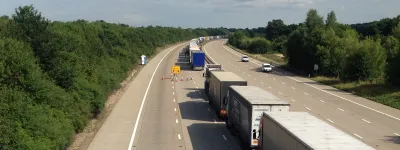The A465 Heads of the Valleys Road runs across the northern edge of industrial South Wales, providing a fast east-west connection between Swansea, Merthyr Tydfil and connections towards England. It's not just a fast, major road; it's also one of the most varied and scenic major routes in the UK.
Most of the present road was built as a fast new road in the 1960s, involving incredible feats of engineering that are now largely forgotten. Now the same road has been ripped up and rebuilt all over again to provide a continuous dual carriageway, involving ever more impressive engineering work.
This is the story of how today's road came to be, and how the way was paved for the new road being built in the 21st century.
Introduction
South Wales is one of the world's least likely and most extraordinary industrial landscapes. Here, the industrial revolution took hold amid some of the most challenging geography in the British Isles — steep-sided valleys and looming hills; surroundings more associated with a national park than factories and mines.
Communication, and the movement of goods, is more important and more difficult here than elsewhere, and since the Victorians first started building railways to serve the valleys, civil engineers have been forced to find ever more ingenious ways to provide vital infrastructure.
Where the long valleys of South Wales reach the high ground of the Brecon Beacons, the industrial landscape suddenly gives way to breathtaking scenery and wide open spaces. Running east-west across the top of those valleys, like a boundary between the crowded south and remote, picturesque mid-Wales, is the A465 Heads of the Valleys Road.
Today, the road is in the lengthy process of being upgraded to a high-speed dual carriageway, a motorway in all but name — an ambitious thing to build through deep gorges and windswept moors, cutting across the grain of the land. But nothing about the Heads of the Valleys Road was ever easy.
From Swansea to the Midlands
At the end of the Second World War, Britain's economy needed urgent revival, and the government's top priority was finding ways to enable the tired, depleted industrial centres of the UK to find prosperity again.
Harold Watkinson, Minister of Transport in Anthony Eden's government, geared his department's road programme to this grand purpose. In October 1956, he announced five huge projects to connect cities and industrial areas to promote growth through improved communication. Number four aimed to link Swansea to the Midlands.
"4. A Motor Road from the Midlands to South Wales including the new Ross Spur Motor Road from Upton-on-Severn to Ross and substantial reconstruction of the existing Heads of the Valleys road between Abergavenny and Hirwaun. Also a new motor road from Upton-on-Severn to the outskirts of Birmingham."
The Heads of the Valleys project had first been announced by Transport Minister Alan Lennox-Boyd in 1953, and then went missing from a list of priority road schemes in another statement by his successor John Boyd-Carpenter in February 1955. Gwilym Lloyd George, a Liberal MP, had warned Boyd-Carpenter that "it is bound to lead to serious trouble in Wales if it becomes known that one part of the Heads of the Valleys Road is to be postponed", so its reappearance in the roads programme must have been very welcome.
The "motor roads" of that project became the M5 and M50, and the road from the M50 to Abergavenny was progressively improved over the following two decades. But in engineering terms, it was the reconstruction of the Heads of the Valleys road that presented the biggest challenge.
The old road was narrow, twisting, full of steep inclines and built-up for a substantial part of its length. A plan was devised to replace it entirely between Abergavenny and Hirwaun, to be built in three stages. The road to Swansea — and prosperity — was all set.
Elsewhere on
Roads.org.uk...
Sources
- Inauguration and opening ceremonies, history of road proposals, changes to route and controversy over width of road: BD 24/341
- Rehousing in Gilwern, Blackrock and Brynmawr: MT 39/990
- Tender and contract documents for Section I: MT 39/1071
- Summary of problems with Section I works and contract: MT 123/167, MT 123/171
- Contract details and bridgework changes in Section II: MT 123/174
- List of dualling projects, timescales and costs: Questions asked over £800m Heads of the Valleys upgrade, Wales Online, 01/04/13
- A40 Abergavenny-Raglan dualling, A465 Swansea-Hirwaun dualling, European funding details and John Redwood speech are taken from Hansard.



